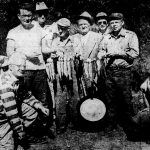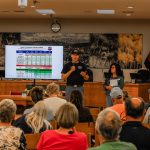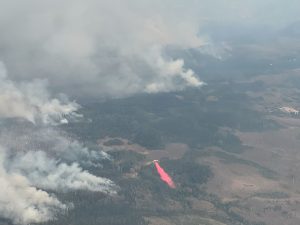What Eagle Valley Wildland is doing to mitigate wildfire risk in Beaver Creek, Bachelor Gulch
The answer to where that brown stripe came from, as well as all the work you can’t see

Eagle Valley Wildland/Courtesy Photo
Whether through the numerous EC Alerts or the visual imprints of the work looking toward Beaver Creek and Bachelor Gulch, Eagle County residents are likely aware of the wildfire mitigation efforts being made in the area by Eagle Valley Wildland.
And while residents have likely seen the newly created stripe down the ridgeline, there’s even more work being done than initially meets the eye.
“What we can see from the highway is just barely the tip of the iceberg,” said Hugh Fairfield-Smith, the wildland coordinator for Eagle Valley Wildland and the Greater Eagle Fire Protection District. “If you go deeper into Beaver Creek and Bachelor Gulch, there’s actually wildfire mitigation basically all the way up to the forest boundary. It goes way up and we are going to be treating close to 600 acres between the two locations this year.”
In total, Eagle Valley Wildland plans to conduct roughly 1,700 acres of treatment in Bachelor Gulch and Beaver Creek over the next three years.
Fairfield-Smith said that these projects will not only protect the homes in the area as well as the ski area infrastructure — which, he said, “would be a huge detriment to our local economy” if impacted by a wildfire — as well as reset the areas’ ecosystem.

Support Local Journalism
The wildfire mitigation projects in this area are utilizing two different methods of treatment: mastication and thinning.

Eagle Valley Wildland/Courtesy Photo
Mastication — which is the work you can see from I-70 — is “basically mowing, but it mulches all the fuel,” Fairfield-Smith said.
This type of mitigation alters the fuel and how it stands on the earth, he added.
“We’re taking it from vertical to horizontal and making it into a vegetation type that does not carry fire fast,” Fairfield-Smith said.
When this was done initially, the work looked like a brown stripe down the ridgeline, which Fairfield-Smith said had led to some concerns from residents. However, this brown was just the shredded wood, which is left to protect the seed bank for grass and protect against erosion issues.
This mastication creates a tactical fuel break, which not only supports a healthy ecosystem, “as the animals are able to move freely through here and then also grasses will come back onto those tactical fuel breaks,” but also gives firefighters a place to engage in case of a wildfire in the area, Fairfield-Smith said.
Ridgelines are often chosen for these tactical fuel breaks. The hope is that the breaks will keep the fire out of drainage areas — preventing watershed issues like what is occurring with the Grizzly Creek burn scar in Glenwood Canyon — as well as provide a place where firefighters can apply retardant to strengthen their ability to fight the fire.
“We have the highest likelihood of holding a fire on the ridge systems versus mid-slope or something like that,” Fairfield-Smith said.

Eagle Valley Wildland/Courtesy Photo
While less visible to residents, the second type of treatment is the thinning of fuels within the forest. Specifically, this refers to work by hand crews where they cut sick, dead and down components as well as ladder fuels that lead up to the trees, Fairfield-Smith said. These fuels are then piled and burned.
“This winter — as conditions allow, like when there’s snow — we will definitely be burning a lot of piles,” he said.
This work not only helps reduce fuels in the event of a wildfire but also is part of “healthy forest management,” Fairfield-Smith said.
Prior to Eagle Valley Wildland’s work in the area this summer, the forest health was on the decline, he added.
“The serviceberry was coming in and it was actually killing all the aspen. So the aspen stands are on the decline. So we’re trying, hopefully, to reset the aspen stands to be much healthier because they’re not competing for resources,” Fairfield-Smith said. “A healthy ecosystem and a healthy forest is much more resistant to wildfire.”
While the current project scope is scheduled over the next three years, the idea is the work is an investment in the future. Not only would it hopefully reduce the risk of severity in the event of a wildfire, but also will kick off a maintenance cycle that will maintain the forest health of these areas.
“The whole idea is that we do more now and a little bit later, and that will keep the forest at a healthy place and the dollar investment will be much less, hopefully,” Fairfield-Smith said.
The projects in Beaver Creek and Bachelor Gulch were funded by investments from several entities including both areas’ metro districts as well as the “Beaver Creek resort company,” Fairfield-Smith said.
According to Bill Simmons, the general manager of the Beaver Creek Metro District, this is an investment well spent.
“The threat of wildfire and the devastation that can be caused has been seen throughout the Western states. Mitigating that threat is the reason that the BCMD Board decided to reach out to Eagle Valley Wildfire to develop a plan,” Simmons said. “The district recognizes that wildfire mitigation is a long-term commitment and — with Hugh’s assistance in developing a maintenance plan — to protect the community in the future.”
Eagle Valley Wildland also receives funding from the county, fire districts and the Bureau of Land Management for its staff positions and for the various projects it conducts.
This investment into the future is something property owners across the county also seem to understand.
“Overall, I think the community is very educated and proactive against wildland fire. We don’t want an East Troublesome event in Eagle County or we don’t want to lose an entire neighborhood,” Fairfield-Smith said. “Overall, the county is very proactive with wildfire mitigation.”
Across the county
The work in Bachelor Gulch and Beaver Creek is only a portion of the mitigation efforts being spearheaded by Eagle Valley Wildland in the county. According to Fairfield-Smith, the organization is implementing, has implemented, or is going to implement similar efforts in Minturn; its completed work in Wildridge as well as near Eagle Ranch; and it has future plans for work in Singletree, Cordillera, Homestead, Wolcott and Gypsum.
These projects are chosen based on a number of considerations, including proximity to residences and infrastructure.
“We use science to drive our decision-making model,” Fairfield-Smith said. “We look at things like: What is the likelihood of a wildfire occurring? What is the intensity of that wildfire? What is the severity of that wildfire? What is the probability of that wildfire? How hard is that wildfire to put out? And then finally it comes to available land; because we, as Eagle Valley Wildland, only guide the projects or oversee projects that are on town land, municipality land, county land or common space (HOA type land). We just don’t operate on private land.”
Once a project area is determined, the crews get to work on evaluating what mitigation efforts will be most effective, which starts with “a lot of time on the ground,” he said.
“That’s where our experience from fighting some of the largest wildfires in the nation really comes to fruition,” Fairfield-Smith said. “We want to take everything we learned about suppressing wildfires and apply that to being proactive against wildland fire. So if we do everything we would do in a wildfire event, then we’ll be five steps ahead of the game, in theory.”
The organization also uses something called Simtable to model fire behavior and the effectiveness of mitigation efforts.
“With the Simtable, we’re actually able to model what the fire would do before we do any treatment,” Fairfield-Smith said. “Then we come in and we do a fuel reduction — just a model of 60% or 80% fuel reduction — and light the same fire. A lot of times we do it under worst conditions and the fire doesn’t usually do much after that.”
While the main goal of these efforts is public safety, it’s also to protect what makes Eagle County what it is.
“We want to respect why people live here; we all live here for a reason — the natural beauty — and so we’re also trying not to impact that,” Fairfield-Smith said.











